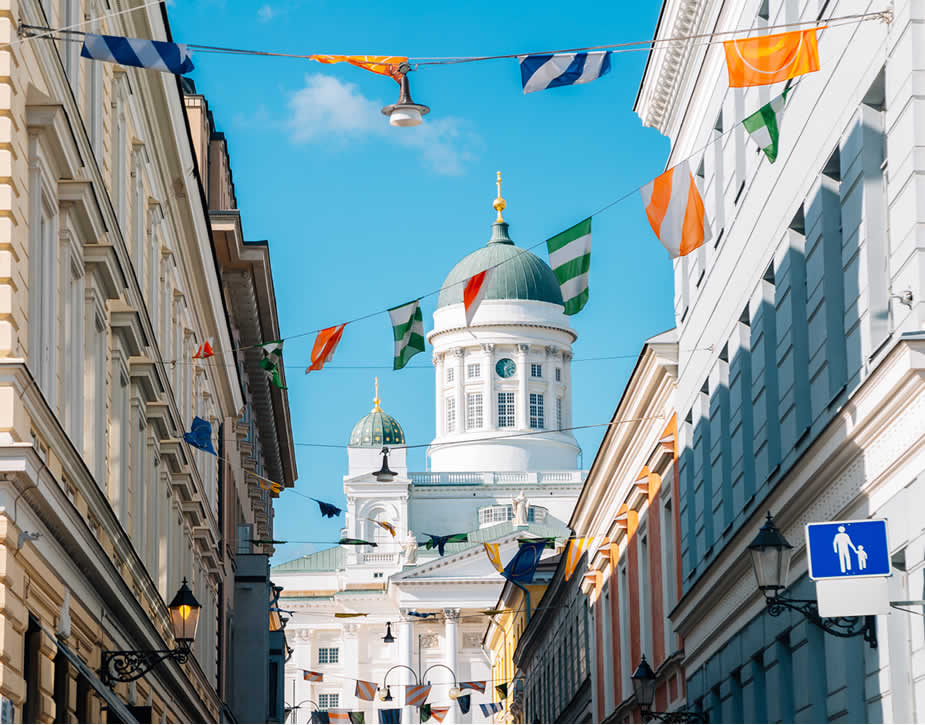Living in Finland – tips worth considering
As we helping with your relocation across the whole of Europe we also gathered some useful information for you to read before you decide to change your surroundings and become an expat in Finland.
In this post, you will learn some information about the days off, both for you and your children. Moreover, you will get some useful information about the housing and registration of your vehicle. Also, we prepared some information about the cheapest supermarkets, to minimize the expenses in this hectic time.
Public holidays in Finland

The main Christian holidays are Christmas, New Year’s Day, Epiphany, Easter, Ascension Day, Pentecost, Midsummer Day, and All Saints’ Day. The non-Christian holidays are May Day and the Independence Day of Finland. It is common, that shops and offices to be closed during these holidays.
The Finnish calendar also provides for special flag days. A day’s status as a flag day has no formal link with an eventual status as an official or as a de facto holiday. However, May Day, Midsummer Day and Independence Day have the status of both a flag day and a public holiday.
The flag of Finland is considered a solemn item and it is flown on certain days that are marked in the calendar. Both official instances and private persons fly the flag on flag days.
It is worth mentioning, that if the date of the holiday falls on a Saturday or Sunday, then the holiday will not be moved to a weekday. Finnish public holidays include:
- New Year’s Day (Uudenvuodenpäivä) – 1 January
- Epiphany (Loppiainen) – 6 January
- Good Friday (Pitkäperjantai) – The Friday before Easter Sunday (moveable)
- Easter Sunday (Pääsiäispäivä) – (moveable)
- Easter Monday (pääsiäispäivä) – The day after Easter Sunday (moveable)
- May Day (Vappu) – 1 May – See Walpurgis Night
- Ascension Day (Helatorstai) – 39 days after Easter Sunday (Moveable Thursday)
- Pentecost Sunday (Helluntaipäivä) – 49 days after Easter Sunday (Moveable Sunday)
- Midsummer Eve (Juhannusaatto) – Non-official – Non-business day in the Annual Holidays Act (162/2005) – holiday in some collective labour agreements (Friday between 19 June and 25 June)
- Midsummer Day (Juhannuspäivä) – Moved from 24 June (Saturday between 20 June and 26 June)
- All Saints’ Day (Pyhäinpäivä) – Moved from 1 November (Saturday between 31 October and 6 November)
- Independence Day (Itsenäisyyspäivä) – 6 December
- Christmas Eve (Jouluaatto) – Non-official – Non-business day in the Annual Holidays Act (162/2005) – holiday in some collective labour agreements (24 December)
- Christmas Day (Joulupäivä) – 25 December
- St Stephen’s Day (Joulupäivä or Tapaninpäivä) – 26 December
School holidays in Finland
Finland is divided into school holiday regions and has different autumn-, Christmas-, winter- and summer holiday periods. School holidays in Finland are set by the Finnish National Agency for Education.
In Finland, the state determines the number of holidays that schools can have while individual schools, public or private, determine the dates for these holidays. Therefore, each school in Finland sets its holiday dates, and in some cases, the lower grades and upper grades of the same school may have different holiday dates.
The duration of each break looks as follows:
- Autumn Holiday: 2-7 days
- Christmas Holiday: 1-2 weeks
- Winter Holiday: 1 week
- Summer Holiday: 10-11 weeks
Car insurance and taxes in Finland
If you have moved to Finland and are living there permanently, you are not allowed to use even temporarily a vehicle registered abroad on the road in Finland without paying car tax there.
You must pay car tax in the following circumstances:
- You took a vehicle with you from a foreign country and you are re-registering it in Finland.
- You buy a vehicle in Finland that has no registration. You are registering it for the first time.
- You put a vehicle into operation in Finland – unless it is a vehicle subject to tax-exempt use.
Car tax is collected for all motor vehicles registered for the first time in Finland, or put on the road for the first time, including passenger cars, vans and buses, motorcycles and other L-category vehicles.
The Finnish Transport and Communications agency (Traficom) collects vehicle tax from car owners once a year.
The Tax Administration does not provide estimates on the level of car tax or the taxable value of vehicles. The Tax Administration’s decision on car tax contains the information you need on how much you must pay.
You can make estimates yourself:
- by inputting data on the motor vehicle you have. This way, you can get a good estimate of the car tax to be collected.
- by looking into the authorities’ previous decisions on car tax. This method will give you a rough estimate.
When you make the estimate, you must remember that market values change over time, and vehicles of the same make and model may be taxed differently at different times.
Supermarkets in Finland
Most people do their food shopping at one of the big supermarket chains, as it is more convenient and economical. The major companies are the Kesko Corporation and S-Group, with Lidl also competing in the market.
In the food retailing sector, Kesko owns K-Market, K-City market, K-Extra, and K-Supermarket. S-Group has Sale, Alepa, Prisma, and S-Market. Lidl is Lidl!
These supermarkets range from small convenience stores to huge hypermarkets designed to provide customers with a one-stop retail outlet for all their needs.
The biggest markets are often located on the peripheries of big towns and cities, whereas ‘urban’ supermarkets can be rather small with a limited selection. So even if you live close to the center of the town, it does not guarantee the biggest choice of groceries, although there may be more specialized shops such as butchers and greengrocers available in the vicinity.
If you would like to save some money on groceries, you can consider doing shopping in ‘discount stores’ such as Lidl, Sale, Alepa, and K-Market.
- Lidl has relatively low prices; it is considered to be one of the cheapest ways to buy groceries in Finland, even without loyalty program benefits. Lidl imports a lot of cheap gourmet foods from Europe; they don’t offer so many familiar brands, nor is their range consistent, so Lidl might not be for everyone. Also, there are still few Lidls in Finland, in comparison to other European countries. Therefore, you may not have one nearby.
- Sale is around 5-10% cheaper than K-Market
- A 2017 study by Kauppalehti found Prisma and S-Market to have overtaken Lidl as the cheapest grocery store.
Get to know your local stores; with a little picking and choosing you’ll eventually have a bunch of favourite regular products at good prices.
Housing in Finland
As you move to Finland, you will need to make a decision: shall I rent a flat or buy a house? Let’s take a look at the advantages and disadvantages of both options.
Renting a flat
In Finland, many people rent houses. The biggest advantage of renting is that switching flats is easy, as you do not have to sell your old home and buy a new one.
On the other hand, your landlord may decide to terminate your lease. In such a case, you will be forced to move out of your flat even if you would not wish to.
Another disadvantage is that it is often difficult to find a suitable flat for rent in the largest cities, where the rents are also higher.
Hence, it is advisable to reserve enough time for finding a flat. Some places are very popular and any vacant flats are rented very rapidly. When you have found a suitable place, you should quickly decide whether to rent it or not.
According to Finnish law, a landlord choosing a tenant must not discriminate against anyone based on factors such as ethnic origin, religion or nationality.
Buying a house
In the long term, the owner-occupied dwelling is oftentimes cheaper than the rental dwelling. Most Finns live in dwellings they own.
Another option is housing share and real estate.
When you purchase a dwelling, it is either a housing share (Asunto-osake) or real estate (kiinteistö).
Housing shares are dwellings in either block of flats or terraced houses. These houses are owned by housing companies.
When you buy a detached house, you buy real estate. Real estate usually comprises a detached house and a related plot.



